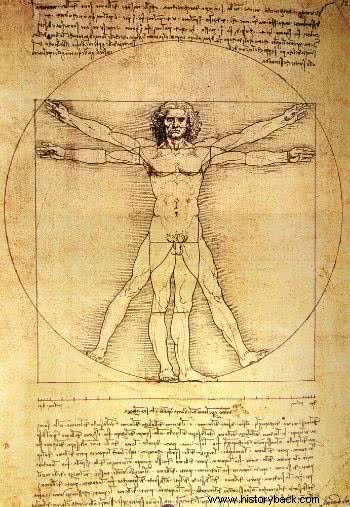It's called Scientific Renaissance the period of development of science during the 15th and 16th centuries.
This time was based on rationalism, humanism and the knowledge of Classical Antiquity that changed people's mentality.
 Vitruvian Man (1490) by Leonardo da Vinci. Iconic illustration of Renaissance Humanism
Vitruvian Man (1490) by Leonardo da Vinci. Iconic illustration of Renaissance Humanism
Based on this knowledge and the discoveries of scholars, this period made possible the advancement of several fields of knowledge that would later inaugurate the Modern Science .
The Renaissance was concerned with studying nature through experimentation and the segmentation of information.
Several men and even women carried out research and, among many, we can mention Leonardo da Vinci. Although he was one of the most important names of the Cultural and Art Renaissance, he also stands out in the Scientific Renaissance, alongside Nicolaus Copernicus.
Despite being very extended, nowadays the word "Renaissance" is used with reservation. After all, this word gives the impression that science was not researched or done during the Middle Ages, which is inaccurate.
Summary:Characteristics and Historical Context
The decline of the feudal system was essential for the emergence of a new order and mentality in Europe.
The Middle Ages was characterized by the feudal system, theocentrism and a status society (king-noble-clergy-serfs), which made social mobility impossible.
In this context, few individuals had access to knowledge, which was transmitted through books and locked away in libraries, like treasures.
During this period of transition, Europe underwent several transformations such as commercial maritime expansion, the emergence of the press and the bourgeoisie.
All this led human beings to question the model of medieval society that was based on the conception that God should be at the center of everything, theocentrism.
In such a way, Humanism and Cultural Renaissance give way to anthropocentrism, where now, man will be the center of the Universe. The way of investigating natural phenomena changes and, consequently, scientists start to have a more critical and active attitude towards the world.
Finally, the Scientific Renaissance had a great impact on European thought at the time and made possible the end of the Medieval Era and the beginning of the Modern Age.
Main Representatives
The main thinkers who were part of the Scientific Renaissance were:
- Nicolaus Copernicus (1473-1543):Polish astronomer and mathematician, considered the “Father of Modern Astronomy”. He was the creator of the Heliocentric Theory (sun as the center of the Universe), in which it contradicts the medieval Geocentric Theory (adopted by the Catholic Church), in which the Earth would be the center of the Universe.
- Galileo Galilei (1564-1642):Italian astronomer, physicist, mathematician and philosopher, Galileo was a supporter of Copernicus' Heliocentric Theory, being considered one of the founders of modern geometry and physics. In addition, he perfected the telescope, invented the microscope with two lenses and the geometric compass.
- Johannes Kepler (1571-1630):German astronomer, mathematician and astrologer, Kepler deepened his theories on celestial mechanics inspired by the heliocentric model, presenting studies on lunar and solar eclipses.
- Andreas Vesalius (1514-1564):Belgian physician, considered the “Father of Modern Anatomy”, Vesalius was one of the forerunners of studies on anatomy and physiology, after dissecting human bodies and writing his main work, an atlas of Human Anatomy entitled “Factory ".
- Francis Bacon (1561-1626):English philosopher, politician and alchemist, Bacon was the creator of the “Scientific Method ” (new way of studying nature), systematizing human knowledge, being considered the founder of “Modern Science”.
- Rene Descartes (1596-1650):French philosopher, physicist and mathematician, according to his studies, Descartes was considered the “Father of Rationalism and Modern Mathematics” and also the founder of Modern Philosophy. His most representative work is the “Discourse on the Method ”, philosophical and mathematical treatise proposing the foundations of rationalism.
- Isaac Newton (1643-1727):English philosopher, physicist, mathematician, astronomer, alchemist and theologian, Newton was considered the “Father of Modern Physics and Mechanics”, from which he developed diverse knowledge in the areas of mathematics, physics and natural philosophy. He studied the motion of bodies proposing the three “Newton's Laws.”
- Leonardo da Vinci (1452-1519):Italian inventor, mathematician, engineer and artist, Da Vinci was considered one of the most prominent geniuses of the Renaissance and human history. He advanced in several studies on human anatomy, and invented the parachute, the flying machine, the submarine, the battle tank, among others.
To complement your research on the topic, see also the articles :
- Renaissance:Characteristics and Historical Context
- Characteristics of the Renaissance
- Cultural Renaissance
- Artistic Renaissance
- Commercial Renaissance
